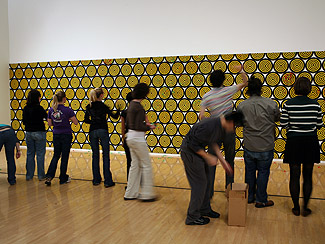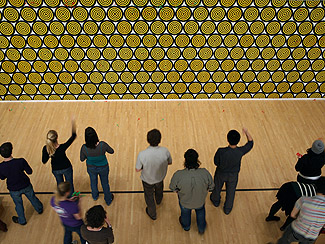Forward, Back, Right, Left Dart boards, canned goods, plastic coffee mugs, striped shirts: the materials of Jacob Dahlgren's art come from the most quotidian of sources. Trained as an abstract painter, Dahlgren celebrates geometric patterns wherever he finds them. Early in his career he grew dissatisfied with the hard-edge abstractions he was painting, frustrated with making arbitrary decisions. Instead of inventing new compositions, he began to replicate stripe patterns from T-shirts, painting their precise colors, thicknesses, and intervals in acrylic on board. He discovered a way to make other pictorial works by accumulating products, such as clothes pins, yogurt cups, or packages of dried food. Using found objects allowed him to expand into space, organizing elements selected from his environment into sculptures, installations, and performance. I, the World, Things, Life, is a signature work, demonstrating how Dahlgren creates occasions that we can experience as abstraction on the fly - an art moment within the flow of daily life. Some such moments are constructed: Demonstration and the performance Signes d'abstraction, screened in the museum lobby and elevator, document events where Dahlgren mobilized numerous collaborators to bring a richly aesthetic experience into public sites. Other abstract opportunities are discovered by the perceptive artist. His photographic series Signs of Abstraction, projected in the adjacent gallery, samples his own experiences of finding stripes and other abstract patterns wherever he goes and capturing them with his camera. In fact, just to meet the artist is to encounter the wonderful world of abstraction - to quote another work - because Dahlgren wears a striped pullover every day, choosing from a collection that currently numbers more than one thousand. Across the 20th century, one strand of vanguard art sought to erode the division between "art" and "life," whether pasting scraps of newspaper onto cubist paintings like Picasso and Braque, designing functional objects at the Bauhaus, or prompting viewers to complete the work of art, as happens when one casts a shadow on Rauschenberg's early white paintings. This aspect of modern art found its culmination in "relational aesthetics," characteristic of the generation of artists preceding Dahlgren. In the work of Rirkrit Tiravanija or Liam Gillick, for example, performances are designed and art objects constructed to orchestrate collective activities. Like many younger artists, Dahlgren circumvents this theoretical discourse and wears his learning lightly. You come to the gallery, see the dartboards, and play; groups of people dress in striped shirts, meet at a bar, and drink beer. His works engage the audience indelibly, yet simply; they proffer their conceptual depths only when requested. Elizabeth A. Brown |
|
 |
 |
Henry Art Gallery http://www.henryart.org/ |
|